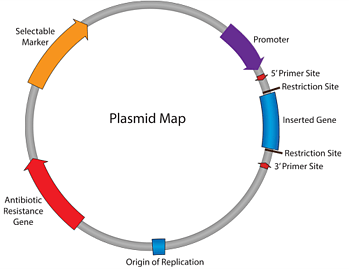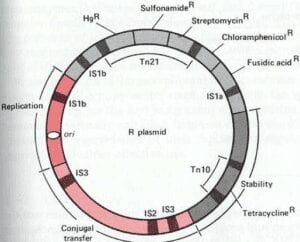Plasmid: Properties, Types, Replication and Organization
Properties of Plasmid
- Many prokaryotes contain extrachromosomal DNA molecules, The genetic material present in the nucleoid is known as plasmid.
- Some yeast and fungi also contain plasmid along with prokaryotes.
- Plasmid are small, extra-chromosomal, circular, super-coiled, double stranded DNA molecule present in mostly all species of bacteria.
- A plasmid is a DNA molecule, other than the bacterial chromosomes that has the ability of replication and transmission independently.
- Plasmid has been documented in both circular and linear form but most known and common plasmids are circular.
- The plasmid term was first introduced by Joshus Laderberg in 1952.
- Plasmids are also known as extra chromosomal replicons, sex factors, conjugans, transfer factors.
- Plasmids have generally few genes, most often less than 30.
- Plasmids are also acts as a vectors.
- Genetic information of plasmid is not essential for the host and cells function normally in their absence.
- Absence of plasmid does not kill bacterium, but their presence provides extra benefits to the bacterial cell.

- Plasmids are able to replicate autonomously.
- Plasmids are circular, some may exist either independent or some are integrated into the chromosome and thus replicated with the chromosome, the latter are called Episomes.
- During cell division, plasmids are inherited stably but, they are not always equally apportioned (share) into daughter cells and sometimes are lost. The loss of plasmid is termed as Curing.
- Copy number: It refers to the number of copies of plasmid present in a cell. Larger plasmids are present in few numbers and small plasmids found in many copy number.
- Compatibility: It refers to the ability of two different plasmids to coexist stably in the same bacterial cell.
Types of plasmid
There are various types of plasmids on the basis of their mode of existence, spread, and function.
- F plasmids or F factors.
- Col plasmids
- R plasmid or R factors
- Virulence plasmids
- Metabolic plasmids.
F plasmids or F factors

- Also known as fertility factor, responsible for the conjugation.
- Conjugative plasmid: they have genes for the existence for the construction of hair-like structure called pili and can transfer copies of themselves to other bacteria during conjugation.
- Most studied conjugative plasmid is F plasmids of coli and it was the first conjugative factor to be described.
- It is conjugative plasmid that contains tra genes (transfer genes).
- In addition to tra genes, it contains a number of other genetic sequences responsible for incompatibility, replication, and other functions.
R plasmid or R factors

- R plasmid is another group of important plasmids, also known as resistance factors, carries genes for antibiotics resistance.
- R factors contains genes that code for enzymes which have the capability to destroy or modify antibiotics.
- Some R plasmids have only a single resistance, whereas, other have as many as eight.
- R plasmid are very essential in human health since they make bacterial cells resistant to specific antibiotics.
- These plasmids provide protection on to bacteria from both human medicine and from antibiotics produced naturally in the soil.
- This plasmid are large size and present in low copies per host cells.
Col plasmids
- Col plasmid contains genes for the synthesis of bacteriocins known as colicins.
- This plasmids codes for colicins, the proteins that kill sensitive coli cells, it also carry gene that provide immunity to the particular colicins.
- They are also known as bacteriocinogenic plasmid as they produces bacteriocins.
Virulence plasmids
- This plasmid encode factors that make their hosts more pathogenic.
- For example: Enterotoxigenic strains of E. coli causes traveler’s diarrhea just because they contains a plasmid which codes for an enterotoxin.
Metabolic plasmids
- This plasmid are holding genes for enzymes that degrade substances known as aromatic compounds (toluene), (2,4-dichlorophenoxyacetic acid), pesticides and sugars (lactose).
- Metabolic plasmids carries the genes which are mostly required for some strains of Rhizobium to induce legume nodulation to carry out nitrogen fixation.
Replication of plasmid
- Mainly due to replication control system, each plasmid is maintained in the bacterial cell at a characteristic copy number.
- On the basis of this, the plasmids are of the following two types:
- Single copy plasmid
- Multicopy plasmid

- The replication control of single copy plasmid, is same as that of host bacterial cells so that they segregate and replicate with the chromosomes of bacteria: this is known as stringent replication control.
- In contrast, the replication control of multicopy plasmid is differs from that of the bacterial host genomes so that they undergo more than one replication for each replication of their host genome: this is known as relaxed control.
Modular organization of plasmid
Different models present in the plasmid are as follows:
- Replication module: This is essential for all plasmids and functions only in the natural host or closely related species.
- Sex factors: It is found in only conjugative plasmids and represented by tra genes in F factor and RTF, resistance transfer factor in R plasmids.
- R- determinant module: It is specific only for the R plasmid and contains genes that inactivate antibiotics.
- Col module: It contains genes for the colicins.
- Modules specifying restriction modifications systems: e.g. ECoRI system.
- IS (insertion sequence): It enables transposition.
Plasmid: Properties, Types, Replication and Organization
Also Read:
- Difference between Prokaryotes and Eukaryotes
- Bacteriophage: characteristics and replication of lytic and lysogenic cycle
- Amino acids: Structure, Optical activity and Classifications
- Microbial Identification and Strain Typing Using Molecular techniques
- Whole-Genome Shotgun Sequencing: overview, steps and achivements
- Tools of Genetic Engineering to Make Genome Modifications
References and Sources
- https://www.biotechnologynotes.com/recombinant-dna-technology/3-main-classification-of-vectors-withdiagram/395
- https://microbiollogy.blogspot.com/2013/09/microbial-molecular-biology-and-genetics.html
- https://www.yourarticlelibrary.com/biology/various-transposable-elements-found-in-prokaryotes-andeukaryotes-organisms/22957
- https://en.wikipedia.org/wiki/Plasmid
- https://quizlet.com/6655915/biology-of-microorganisms-chapter-3-flash-cards/
- http://www.wikidoc.org/index.php/F-plasmid
- https://www.biologydiscussion.com/plasmids/plasmids-definition-types-and-replication-microbiology/54754
